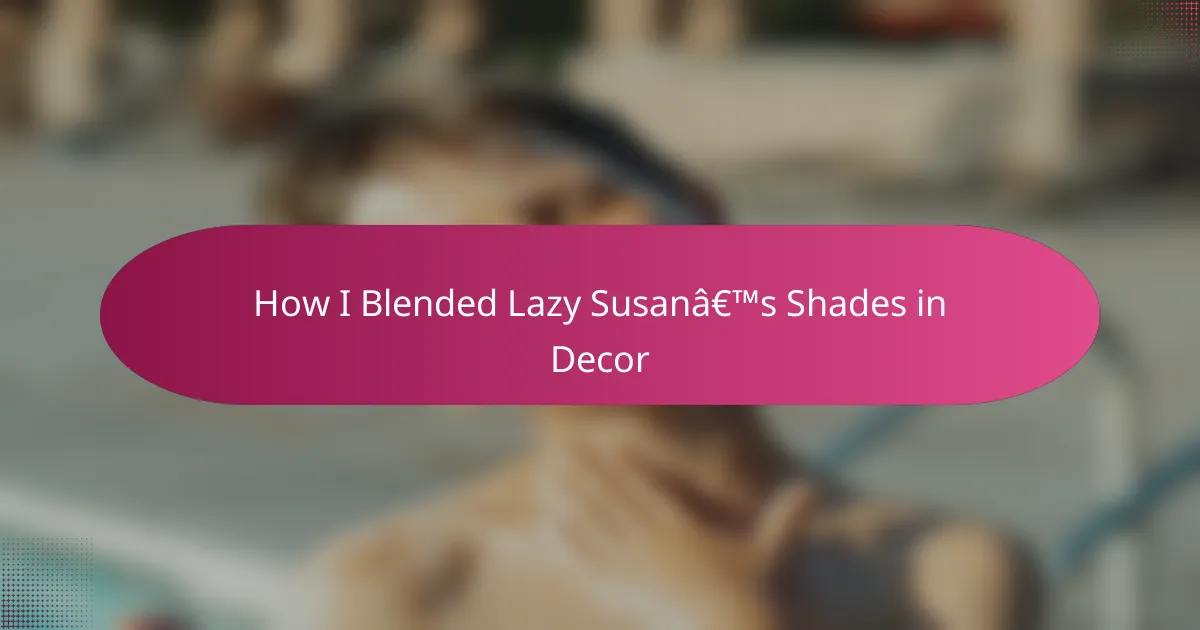Key takeaways
- Modern nursery design focuses on creating a calming and inspiring environment, combining aesthetics with practicality to enhance emotional connection and development.
- Color choice plays a crucial role in setting the mood, where pastels provide calmness and brighter tones encourage playfulness, creating a harmonious atmosphere.
- Lazy Susan shades introduce subtle, rotating color variations that add depth and warmth while adapting to a child’s growth, fostering curiosity and serenity.
- Incorporating textures and thoughtful lighting helps create a nurturing space that evolves with the child’s needs, making the nursery feel lived-in and loved.

Understanding Modern Nursery Design
Modern nursery design isn’t just about style; it’s about creating a space that feels safe, calming, and inspiring for both baby and parents. I’ve often found myself reflecting on how color choices and textures can subtly influence a baby’s mood and development, making every decision deeply personal. Have you ever noticed how a simple shade or pattern can transform the energy of a room?
In my experience, modern nurseries embrace minimalism balanced with warmth—clean lines paired with soft fabrics, and functional furniture that grows with the child. It’s this thoughtful approach that makes the space not only beautiful but truly livable. When designing, I ask myself whether each element serves a purpose beyond aesthetics, because practicality is just as vital as charm.
But perhaps what resonates most with me about modern nursery design is its focus on emotional connection. The right environment can foster comfort and creativity, helping parents bond with their little one while anticipating their future milestones. Isn’t that the heart of any nursery — a nurturing haven that adapts and evolves?

Choosing Colors for Nursery Decor
Choosing colors for nursery decor goes beyond picking hues that simply look good. I’ve learned that certain shades can create calming vibes, while others spark curiosity and playfulness. Have you ever noticed how soft pastels seem to lull a baby into calm, whereas brighter tones invite more energetic interactions?
When I first selected colors for my nursery, I approached them like a palette to balance mood and functionality. Neutral shades like muted grays or gentle beiges often become the perfect backdrop for the room, allowing vibrant accessories or toys to stand out without overwhelming the senses. This subtle layering feels both cozy and modern to me.
Sometimes, it’s also about how colors blend together. I’ve found that mixing cool tones with warm ones can create a soothing yet inviting ambiance that feels just right — neither too stark nor too busy. Does the color harmony in your nursery inspire a sense of peace or playful energy? That’s the question I’m always asking as I make each choice.

What Are Lazy Susan Shades
Lazy Susan shades might sound like a quirky nursery accessory, but they’re actually a clever design concept inspired by the rotating shelves we all know from kitchens. To me, these shades refer to carefully selected hues that revolve gently around a central palette, creating a dynamic yet harmonious flow in the room’s decor. Have you ever thought about how subtle shifts in shade can make a space feel more alive without overwhelming it?
When I first experimented with Lazy Susan shades in my own nursery designs, I noticed how the gradual transitions between colors could add depth and softness to the environment. It’s like watching a color carousel that slowly turns, offering fresh visual interest at every glance. This idea brought a sense of movement and calm that conventional block colors just didn’t capture for me.
I often wonder if we underestimate the power of shade variations in shaping a nursery’s mood. Lazy Susan shades aren’t about bold contrasts; rather, they embrace subtlety and rhythm, encouraging a soothing yet engaging atmosphere. Isn’t that exactly the balance we aim for when decorating a space meant for such tender moments?

Integrating Lazy Susan Shades in Nurseries
Integrating Lazy Susan shades into nursery decor felt like an intuitive step for me, especially when I considered how softly rotating hues could mirror the gentle rhythms of a baby’s day. Have you ever noticed how subtle color shifts can feel almost like a lullaby for the eyes? I found that positioning these shades around key nursery elements—like storage units or seating—added an effortless grace that invites calm exploration.
What surprised me most was how these rotating palettes didn’t just add beauty but also a functional rhythm to the nursery space. When I used Lazy Susan shades on walls or curtains, it created a visual flow that seemed to move with the child’s energy, adapting as they grew. Does it make sense that this subtle movement in color could actually foster curiosity while maintaining serenity?
I also came to appreciate how this approach allowed flexibility in decorating choices—it’s like having a built-in design guide that evolves naturally. When one shade softly turned into another, I felt the room breathe, growing from a newborn’s sanctuary into a vibrant toddler’s playground without feeling disjointed. Isn’t that the dream for any nursery design—to grow seamlessly alongside the child?

Tips for Blending Lazy Susan Shades
Blending Lazy Susan shades is all about creating a smooth transition between colors that feel connected yet distinct. I’ve found that starting with a central shade and gently rotating through variations—lighter, deeper, or warmer versions—helps maintain harmony without causing visual fatigue. Have you ever noticed how abrupt color changes can disrupt a room’s calm? This technique avoids that entirely.
Another tip I swear by is to think about the textures alongside your shades. When soft fabrics or matte finishes meet these rotating colors, the space feels even cozier and more layered. From my experience, combining subtle shade shifts with tactile contrasts makes the nursery inviting both visually and physically. Doesn’t that tactile comfort add another layer of nurturing?
Finally, I recommend considering how light affects your chosen Lazy Susan shades throughout the day. Watching how soft daylight or evening glow shifts these hues gave me new appreciation for their dynamic nature. When I adjusted shades based on natural light patterns, the nursery felt alive yet restful—a balance that feels just right for a growing child. Isn’t it amazing how light can deepen the story your colors tell?

Personal Experience with Lazy Susan Shades
When I first introduced Lazy Susan shades into my nursery design, I was genuinely surprised by how much they shifted the room’s energy. It wasn’t just about aesthetics; it felt like the colors were gently guiding the atmosphere throughout the day. Have you ever experienced something so simple yet so transformative in a space? That subtle rotation of shades became almost soothing, like a quiet companion to the baby’s daily rhythms.
I remember a particular afternoon when the sunlight hit the nursery curtains just right, and the Lazy Susan shades revealed their true magic. Watching the colors blend and flow softly made me realize how alive a room can feel without any brash statements. It felt deeply nurturing, as if the space itself was embracing both baby and parent in a calm, evolving hug.
What struck me the most was how these shades adapted seamlessly as the nursery’s needs changed. From newborn quietude to toddler playfulness, the gradual shifts in color never felt jarring—they simply moved with us. Isn’t that the dream for any parent designing a nursery? A space that holds onto its warmth and charm while growing effortlessly alongside your child.

Final Nursery Design Styling Ideas
Final nursery design styling ideas bring all those thoughtful colors and textures into a cohesive story. I remember arranging soft cushions and playful mobiles, each echoing a shade from my Lazy Susan palette, and suddenly the room didn’t feel like separate pieces but a gentle symphony. Have you ever noticed how those little details—like layering a cozy rug or choosing curtains that catch the light just right—can make a nursery feel truly lived-in and loved?
Sometimes, the magic lies in the unexpected. I found that mixing natural elements, such as wooden toys or woven baskets, with the smooth, rotating shades added a grounding warmth that balanced the airy softness. It made me think: how often do we overlook tactile variety when focused on color alone? That contrast gave the nursery an inviting texture, like a whisper that says, “this space is for tender moments and joyful exploration.”
One final touch that felt essential was lighting. By choosing adjustable lamps and fitting soft, dimmable bulbs, I created a space that could shift from bright playtime to calm bedtime with ease. Reflecting on this, I realized nursery styling isn’t just about looks—it’s about crafting an environment that breathes alongside your child’s changing needs. Doesn’t that feel like the heart of modern nursery design at its best?
